Are your advocates failing to mobilize behind your latest issue or donate to your cause despite all your hard work and worthy campaign?
Ever consider it might be the way YOU wrote that Call to Action?
You don’t have to be Shakespeare to motivate your supporters to sign that petition, write to Congress, comment on Regulations.gov or make a donation.
The good news is there’s a tried and tested formula. And we’re going to show you how to apply it so you get results every time. Read on to see how.
First things first. Get your Legislative Action Center or Online Donation Page in order.
Action centers are enormously important because they address four of your most critical needs:
- A need for an accessible space on the web to house all of your advocacy calls to action
- A need for a resource hub to educate your members and supporters on your policy issues
- A need for a public demonstration of your advocacy program’s work and progress in order to justify its existence (Look, everyone! See all these bills and issues we’re constantly monitoring?)
- A place to bring people so they can take action on that important campaign you’re working on.
As a bonus, they also provide something concrete for members and donors to picture in their minds in that first micro-second of processing their brain does immediately after they are asked to renew their dues or give another donation.
Here’s an example of a good Legislative Action Center from AIDS United (an Engage client):
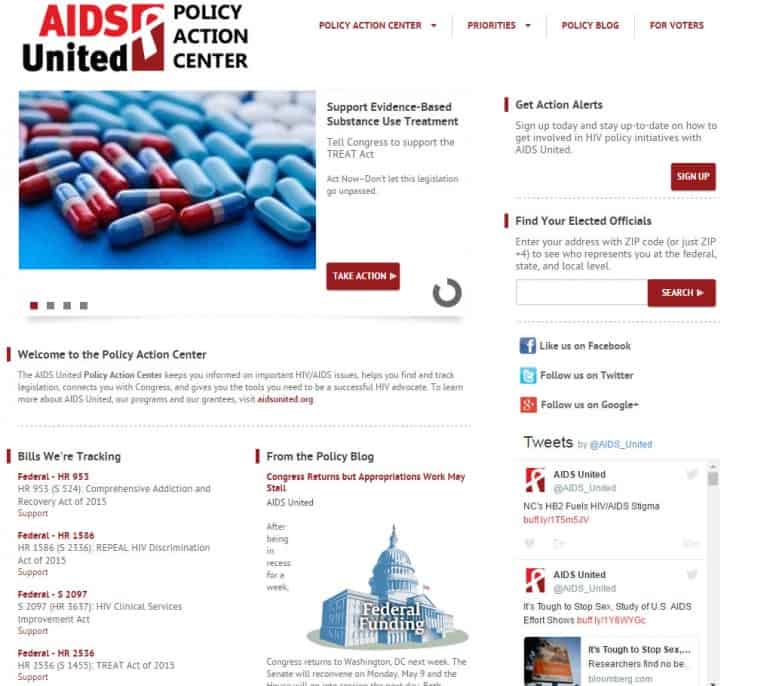
Where on the Page Should I Place My Call to Action?
What you’re not going to do is fall into the following common thought trap:
Because our cause or issue is so worthy, web visitors will spend however much time it takes to find my call to action, so I’ll put it somewhere other than the top of the page – that way, they’ll see all this other cool stuff along the way, like newsletter sign-ups and blog posts, which means they’ll actually interact with two or three other items in addition to taking the Advocacy Action I want them to take.
Just like in the AIDS United screenshot, you want to give your call to action lots of prominence.
Human beings have short attention spans and are busy doing other things – don’t make them hunt for your
call to action.
Place it at the top, or top-left corner, of the page.
You’ll also need to create a dedicated landing page to click off to.
What Copy Should I Include in My Call to Action?
Here are the five components we recommend that all your calls to action should contain:
- A headline
- Impactful image
- Background blurb
- Action button
- Legislative details
Let’s break down each of those components, one by one:
A headline
Headlines are hard to write, until you think of them as formulas, and then they become easy.
And you feel like a hero for knowing how to write them with confidence going forward.
The formula is simple: all of your call to action headlines should contain three elements, and these three elements
should occur in a particular sequence.
We will provide full calls to action headline examples at the end of this section, but first, let’s start with the three elements that all of your calls to action headlines should contain:
- A specific pain or consequence if action is not taken OR a specific benefit that will occur once action is taken
a. Pain or consequence example: “800,000 Monarch butterflies will die unless…”
b. Benefit example: “…over 16,000 new clean-water wells will be dug…”
2. A number
The number you use can either quantify the consequence (“800,000 dead butterflies”), the benefit (“16,000 new wells”), your objective (“We’re collecting 10,000 signatures”), or your timeline
(“…in 30 days…”)
3. A timeline
a. You have several options here that you can map your timeline to:
i. A timeframe of implementation (“Help us provide 10,000 lunches for local children over the next
four months”)
ii. A legislative lifecycle (“Stop the bill before it reaches the full House floor”),
iii. The legislative calendar (“Tell Congress to act before they head to recess”),
iv. An external event (“This Mother’s Day, tell Congress…”)
4. Legislative details (Optional)
a. Here you’re providing a bill number, or the equivalent (H.B. 123, HR 123, Proposition 7), accompanied
by a support or oppose position (“Stop H.B. 123”)
b. Including the legislative details in the calls to action headline is optional because they aren’t necessary to
provoke interest and action (and can sometime hinder it, as we’ll go into below)
c. Once a legislative measure gains notoriety – this happens most often for controversial bills that get
lots of press – then it makes sense to include it in the calls to action headline

Now the sequence of those headline elements:
- Subject of your action
- Pain or benefit, which will often be tethered to your number
- Timeline
- Legislative details
Here’s an example. Note the sequence:
“Save the world’s 10,000 tallest sequoias from being cut down this year. Support HR 123.”
First: The subject of your action (sequoia trees)
Second: The pain/benefit (save from being cut down)
Third: The timeline (this year)
Fourth: Legislative details (HR 123)
Here’s why the sequence is important:
You must first get your reader to make an emotional connection with the subject matter of your action before s/he will be receptive to the pertinent details.
For that reason, you wouldn’t lead with the legislative details.
Any new advocates you’re trying to recruit won’t care about “HR 123” until they know what “HR 123” is about.
So, put your subject at the beginning of the headline, then make an emotional connection by conveying the pain or benefit that will be visited upon your subject, then create a sense of urgency with the timeline.
Once your new advocate is invested, then give her the legislative details.
We mentioned earlier how starting your call to action headline with a bill number can be a mistake. Here’s why:
A lot of advocacy professionals start their call to action headlines with the legislative details (e.g., “Support HR 123…”) because monitoring legislation is such a big part of advocacy that the shorthand of referring to specific bill numbers can start to creep into the advocacy messaging.
Your advocates are not actively monitoring legislation – they don’t know HR 123 from HR 456 until you tell them why they should care.
Now:
Open up a web browser and go to change.org and browse the call to action headlines – do you notice how virtually none of them have all three elements?
Accomplishing advocacy goals means being deliberately effective across all of the critical details.
And headlines are definitely one of those critical details.
Now that you know what elements to include in your call to action headline, and what their sequencing should be, let’s pull some actual headlines off of change.org and rework them using the formula.
Here’s a call to action headline from the World Wildlife Fund, and below it how that same headline could be rewritten to use the formula:
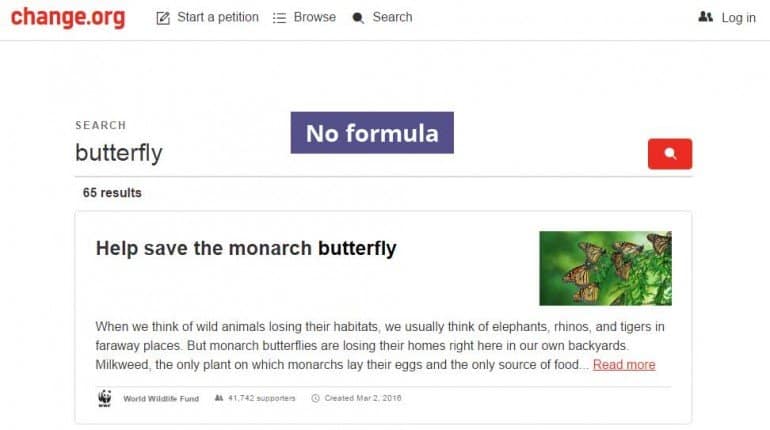
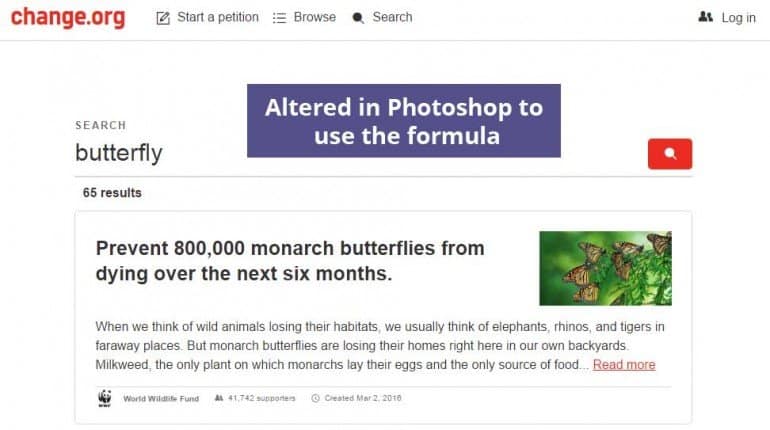
Which one feels more compelling and urgent to you?
Let’s look at another call to action headline. This one is from the Republican National Committee. You will probably remember it from the 2012 presidential election and the 2014 mid-term election:
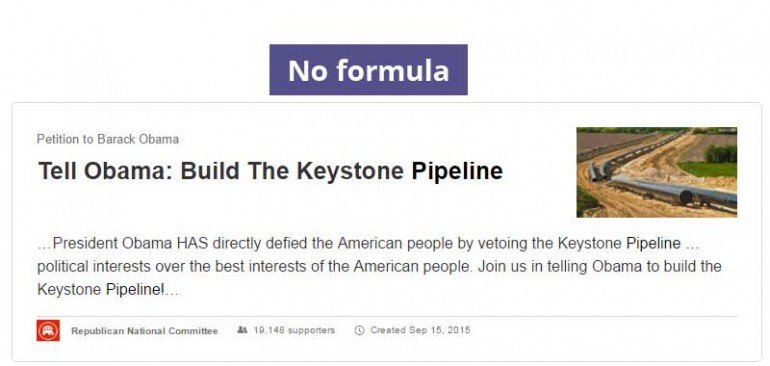
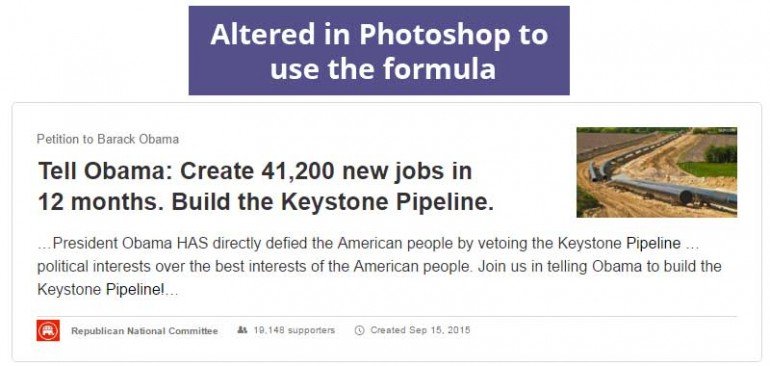
See the difference?
Once you have the formula down, you can take an effective, compelling Support or Oppose position on anything.
Here are some about a fictitious pipeline:
“Save 839 fish and animals species from contamination next year. Stop the North River Pipeline.”
“Create 12,000 new local jobs in 30 days by approving the North River pipeline.”
“Prevent 12,000 layoffs over the next six months by extending the North River pipeline.”
Speaking of change.org, even though the call to action headlines are not always optimized for conversion, a lot of the calls to action do a great job of choosing an impactful image.
Impactful image
You should always (meaning, without exception) accompany your call to action with an impactful image.
Here’s why:
Images very powerfully reinforce your message.
For the same reason that in your call to action headline you want to put the subject first in order to create that initial emotional connection, you want to give your call to action a visual face.
So, how do you choose not just any image, but an impactful image?
The key is to find the overlap between what will resonate with both the advocate and the entity you’re addressing (i.e., the institution or organization that you are trying to influence).
Here are some ideas with successful, real-world examples:
- Human Faces
Choosing an image of a person who is feeling the consequence or pain can be very powerful because it personalizes your cause by identifying a subject to whom your advocates can relate, like this petition on care2.com that reached its goal of attracting 25,000 signatures:

And this successful petition that ran on change.org, decrying acid attacks on women in Uganda, which got the Ugandan government to pass a new law:
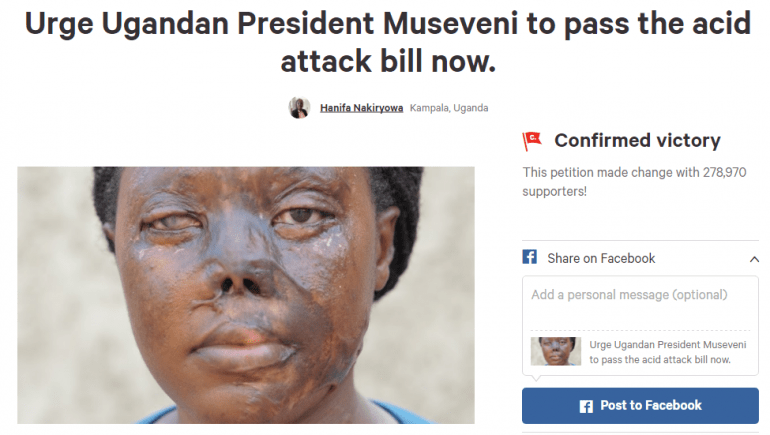
It should go without saying, but we’ll say it anyway, avoid using stock photography in your campaign unless it speaks specifically to your issue. Successful advocacy is built on authenticity.
- Screenshots of social conversations
Social media conversations combine the power of public conversation within a medium (social media) that all organizations and institutions know that they need to pay attention to.
Here’s a successful call to action that got a “Hotties of Melbourne University” Facebook page removed from the university’s Facebook account.
The image is impactful because it depicts the actual Facebook comment thread that reinforces the advocacy argument being made – that such pages normalize the objectification of women, which can contribute to the risk of sexual assault on college campuses:

- Use an impactful video
According to recent research from the marketing company HighQ, 65% of video viewers watch more than 3/4 of a video.
The more you can get an advocate to engage with your message, the greater the chances that s/he will participate in your call to action.
Here’s a video that was part of a successful advocacy campaign to get Kraft Foods to stop using certain food dyes in their products:
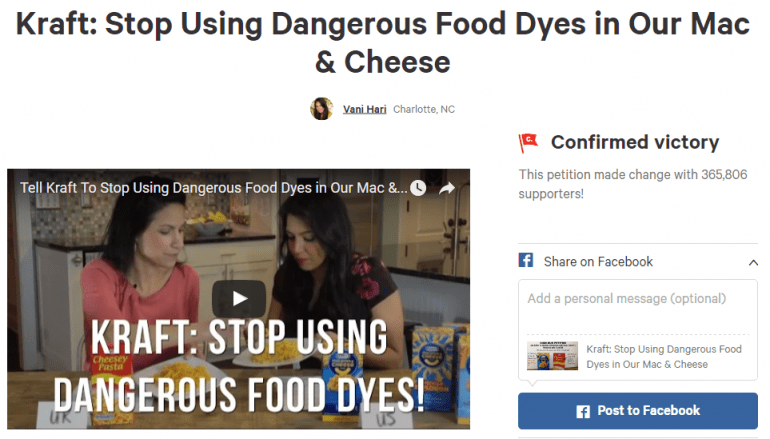
Note: Video production has gotten extraordinarily affordable. If you look at the starting frame of the above example, it’s two women discussing their cause at a kitchen table, surrounded by the product they are trying to influence, and probably could have been shot on an iPhone.
Background blurb
The background blurb is your chance to tell the story of why your advocate should care and why they should act.
Here are two guidelines for writing effective background blurbs:
- Don’t just describe your issue or cause. Tell a story about it.
2. The first 60 words of your Intro are the most important.
And here are the elements your background blurb should contain:
- Intro
- Background/context
- Elaboration on pain/benefit
- Clear call to action with instructions
Let’s look at each one:
Intro:
According to data from Chartbeat, 55% of all pageviews get less than 15 seconds of attention.
No matter how worthy your cause, if your call to action bores or confuses people for even one second, your advocates will lose interest and leave.
Here’s why:
Your call to action is competing with all the other stuff a person could be doing – reading email, checking in on Facebook, watching TV, playing a phone app, etc.
This is why we say the first 60 words of your Intro are the most important.
Here are some copywriting tactics to grab your advocate’s attention and keep her reading:
- Open up an information gap.
2. Get right to the point: keep your sentences short, simple and purposeful.
Open up an information gap, which means they’ll keep reading at least until the next line
You can open up an information gap by building anticipation for unknown information, followed quickly by the promise of providing it, then punctuate it with a colon.
You may (or may not) have noticed, but we’ve been using this trick throughout this entire guide.
In fact, the line “Here’s why:” opens up an information gap.
Here are a few examples:
- “The North River pipeline will provide a huge economic benefit to our area. Here are the two reasons why:”
- “Supporters of the North River pipeline tell you it will create jobs. Here’s the truth:”
- “Opponents of the North River pipeline tell you it will decrease the local bird population. But, here’s what they don’t tell you:”
Keep your sentences short, simple and purposeful
Simple writing means you are being both expressive and easily understood.
Short sentences are easier to read and keep a quicker reading pace.
Purposeful writing means each sentence knows what it wants to accomplish.
Background/context
Tell the story of why someone should care. List the events that have led to the current predicament.
Elaboration on pain/benefit
Be specific about the pain or consequence that will occur if action is not taken, and be specific about the benefit that taking action will have.
Call to action with clear instructions
Be clear about the action you want the advocate to take (e.g. “Sign the petition”).
It’s also a good idea to let your prospective advocate know how long that action will take to perform
(e.g., 30 seconds).
Action button
This one’s pretty simple.
Don’t use “Submit” or “Send” as the text for the button that takes your advocate to the landing page to
perform the action.
Instead, use the words that describe the specific action you want your advocate to perform:
- “Sign the Petition”
- “Tweet Your Lawmaker”
- “Donate Now”
- “Share Your Story”
Legislative details
Your supporters could be living in different parts of the country or the world, so it’s important to provide enough specific legislative detail so that your supporter who lives in Green Bay can Tweet accurately about a specific animal rights ordinance in Jacksonville.
Keep in mind, laws get passed at the federal, state and local level.
So here are the legislative details your Call to action should include:
- The degree of locality (local, state or federal)
- The name of the city or state in which the legislation is being considered
- The bill number (if applicable)
- The bill name


